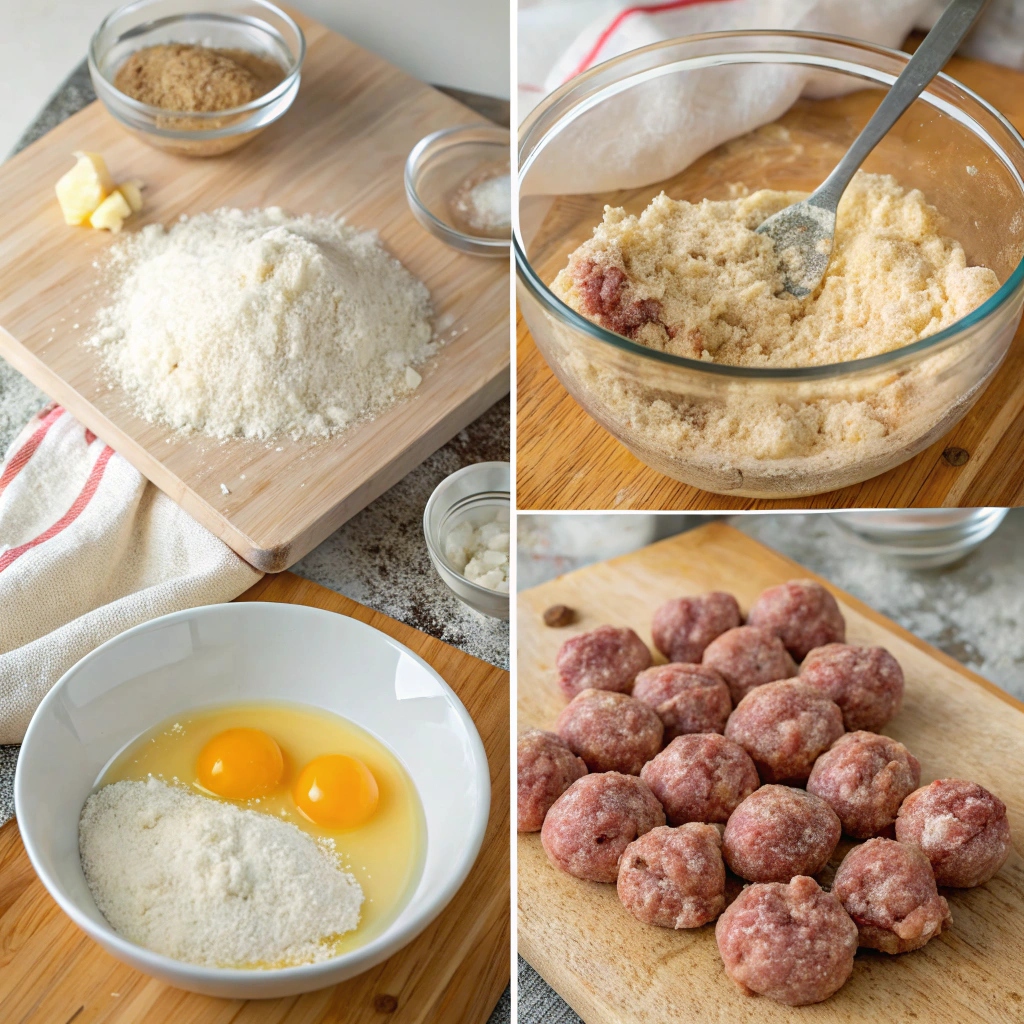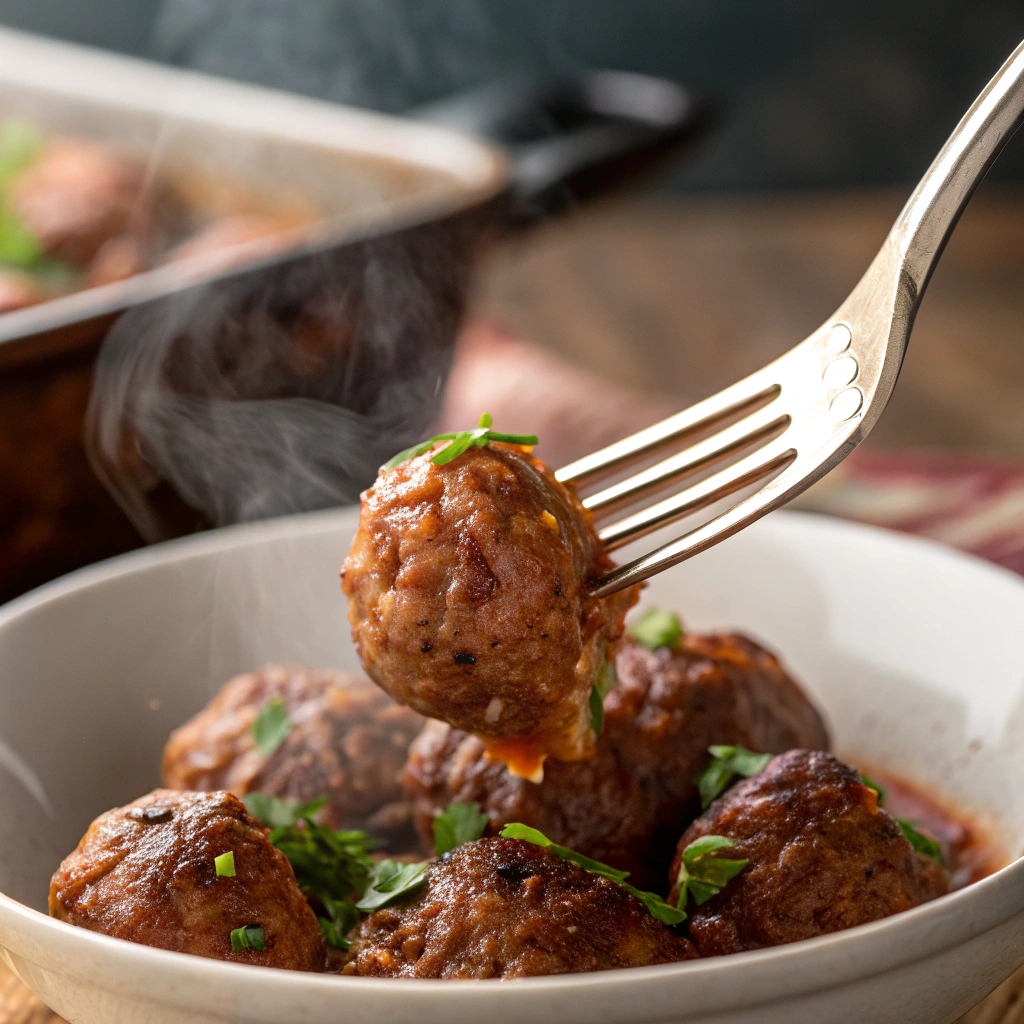When it comes to crafting the perfect meatball, there’s an unsung hero that often gets overlooked—baking soda. While most home cooks rely on traditional ingredients like breadcrumbs and eggs to bind their meatballs, baking soda quietly transforms the texture and flavor. But why does this simple white powder have such a profound effect? Let’s dive into the science and discover how baking soda can elevate your meatball game. 🥩✨
Table of contents
What Are Meatballs Made Of?
Meatballs are a culinary classic found in cuisines across the globe. Whether you’re preparing Italian, Swedish, or Asian-style meatballs, the key ingredients typically include:
- Ground Meat: Beef, pork, chicken, turkey, or a mix.
- Binders: Breadcrumbs or flour to hold everything together.
- Eggs: Provide structure and prevent crumbling.
- Seasonings: Salt, pepper, garlic, herbs, and spices for flavor.
- Moisture Ingredients: Milk, water, or cream to keep them tender.
These ingredients work in harmony to create meatballs that are flavorful, juicy, and cohesive. But even with all these elements, meatballs can sometimes turn out dense, dry, or rubbery. That’s where baking soda steps in to save the day.
The Science Behind Baking Soda in Cooking
Baking soda, or sodium bicarbonate, is an alkaline compound that reacts with acids to produce carbon dioxide gas. When used in cooking, this reaction has two major effects:
- Tenderizing Meat: The alkalinity of baking soda raises the pH level of the meat, breaking down proteins and preventing them from bonding too tightly. This results in a softer, more tender texture.
- Retaining Moisture: By loosening the protein structure, baking soda traps more water within the meat, keeping it juicy and flavorful.
“Think of baking soda as the ultimate meat relaxer—it loosens up the proteins and makes room for all that juicy goodness!”

Why Do Meatballs Sometimes Turn Out Tough?
If you’ve ever bitten into a tough, chewy meatball, you know the disappointment. This common problem occurs due to:
- Overmixing: When the meat is overworked, proteins bind too tightly, creating a dense texture.
- Insufficient Moisture: Without enough liquid, the meatballs dry out during cooking.
- Improper Cooking: Overcooking or cooking at too high a temperature can result in dry meatballs.
Baking soda addresses these issues by tenderizing the meat and enhancing its ability to retain moisture.
Baking Soda vs. Baking Powder: What’s the Difference?
You might wonder, “Can I use baking powder instead?” The answer is no, and here’s why:
- Baking Soda: Pure sodium bicarbonate; requires an acidic ingredient (like vinegar or lemon juice) to activate.
- Baking Powder: A mix of baking soda and an acid, pre-packaged with a neutralizing agent.
For tenderizing meatballs, baking soda is the clear winner because of its pure alkalinity.
A Sneak Peek at What’s Next
Now that we’ve covered the basics of meatball composition and the science behind baking soda, it’s time to explore why you should add baking soda to your recipe. In the next section, we’ll dive deeper into the practical benefits and share tips for avoiding common pitfalls. Stay tuned! 🎯
Why Add Baking Soda to Meatballs?
If you’ve ever wondered why baking soda is often recommended in meatball recipes, you’re about to uncover the magic. This common pantry staple isn’t just for baking—it’s the secret weapon for achieving tender, juicy, and flavorful meatballs. Let’s take a closer look at how baking soda works its wonders in your meatball mixture.
Tenderizing the Meat
One of the main challenges in making meatballs is ensuring they remain soft and tender, especially when using lean meats like chicken or turkey. Baking soda excels here because of its ability to raise the pH level of the meat. This higher alkalinity prevents the proteins from binding too tightly, which can make the meatballs dense and rubbery.
“Adding a pinch of baking soda is like giving your meat a spa treatment—it relaxes the proteins and ensures every bite is melt-in-your-mouth delicious!”
Enhancing Flavor
Baking soda does more than just improve texture—it also amplifies flavor. By breaking down the proteins, it creates more surface area for seasonings to adhere to. This means every bite is infused with the rich flavors of your spices and herbs.
Additionally, the alkalinity of baking soda can neutralize any excess acidity in the meat or added ingredients, creating a more balanced flavor profile.
Achieving the Perfect Texture
Ever noticed how restaurant meatballs seem impossibly soft yet hold their shape? That’s the power of baking soda. It ensures the meat mixture remains pliable during preparation, making it easier to form evenly shaped meatballs.
Here’s a quick tip: For every pound of meat, add about 1/4 teaspoon of baking soda. This small amount is enough to work its magic without overpowering the natural flavors of your dish.

Common Problems When Using Baking Soda in Meatballs
While baking soda is a game-changer, it’s important to use it correctly. Too much or improper mixing can lead to issues. Here are some common pitfalls to avoid:
Using Too Much Baking Soda
More isn’t always better. Excessive baking soda can make the meatballs taste metallic or soapy. Stick to the recommended amount—1/4 teaspoon per pound of meat—to avoid this problem.
Uneven Mixing
Baking soda needs to be evenly distributed throughout the meat mixture to work effectively. Uneven mixing can result in some meatballs being tender and others dense. To fix this, dissolve the baking soda in a small amount of water before adding it to the mixture.
Overpowering Taste
If the baking soda flavor overpowers your meatballs, it may be due to a mismatch of ingredients. Using a balancing agent like acidic tomato sauce or lemon juice in your recipe can help neutralize any residual taste.
Quick Tips for Success
- Dissolve First: Always dissolve baking soda in water or milk before adding it to your meat mixture.
- Use Fresh Ingredients: Stale baking soda won’t give you the desired results. Replace your supply every six months.
- Test a Small Batch: Fry one meatball before cooking the entire batch to ensure the seasoning and texture are spot on.
Tips for Perfect Meatballs and Alternative Methods
Achieving the perfect meatball is both an art and a science. While baking soda is a key player, several other factors contribute to creating tender, flavorful meatballs. In this section, we’ll explore expert tips, practical techniques, and alternative methods to enhance your meatball-making process.
Tips for Perfect Meatballs
Even with baking soda in the mix, there are a few additional strategies to elevate your meatballs to perfection:
1. Balance Ingredients
The ratio of meat to binders (like breadcrumbs) and moisture ingredients (like milk or water) is crucial. A good rule of thumb is:
- 2 parts meat
- 1 part breadcrumbs
- 1/4 part liquid
This balance ensures the meatballs hold their shape while staying moist and tender.
“Think of your meatball mixture as a symphony—each ingredient plays its part to create a harmonious flavor and texture.” 🎵
2. Precise Measurements
Eyeballing measurements can lead to inconsistent results. Use measuring spoons or a kitchen scale to ensure accuracy, especially when adding baking soda. Remember, just 1/4 teaspoon of baking soda per pound of meat is enough.
3. Proper Mixing Techniques
Avoid overmixing, as it can lead to tough meatballs. Use your hands to gently combine the ingredients until just mixed. If using baking soda, dissolve it in water or milk first to ensure even distribution.
4. Chill the Mixture
Before shaping your meatballs, refrigerate the mixture for 15–20 minutes. Chilling firms up the ingredients, making it easier to roll perfectly round meatballs.
5. Cook Gently
Whether frying, baking, or simmering, avoid overcooking, as this can dry out your meatballs. Aim for an internal temperature of 160°F (71°C) for beef or pork, and 165°F (74°C) for chicken or turkey.
Alternative Methods to Improve Meatball Texture
If you’re looking for ways to achieve tender meatballs without baking soda, here are some effective alternatives:
1. Using Dairy Products
Dairy is a natural tenderizer. Ingredients like milk, heavy cream, or even ricotta cheese add moisture and richness to the mixture. Soaking breadcrumbs in milk (a panade) is a classic technique for soft meatballs.
2. Adding Vegetables
Finely grated onions, zucchini, or carrots can boost moisture and create a lighter texture. Plus, they sneak in some extra nutrients! 🥕
3. Experimenting with Other Tenderizers
Acidic ingredients like yogurt, buttermilk, or vinegar can help break down proteins, similar to baking soda. A teaspoon of vinegar per pound of meat works wonders.
4. Adjusting Cooking Techniques
- Steaming: Retains moisture better than frying or baking.
- Slow Cooking: Simmering meatballs in sauce for an extended time makes them ultra-tender.
5. Incorporating Gelatin
Adding a small amount of bloomed gelatin to the mixture can mimic the juicy texture of higher-fat meats.
Common Problems with Alternative Methods
While these methods are effective, they come with their own challenges:
- Overly wet mixtures can make it hard to shape the meatballs. Solution: Add breadcrumbs to absorb excess moisture.
- Strong flavors (like vinegar) might overpower the dish if overused. Solution: Start with a small amount and adjust to taste.
Quick Comparison Table: Baking Soda vs. Alternatives
| Method | Benefit | Drawback |
|---|---|---|
| Baking Soda | Tender texture, easy to use | Must be measured precisely |
| Dairy Products | Adds moisture and richness | Can make mixture too wet |
| Vinegar/Acidic Agents | Breaks down proteins naturally | Risk of overpowering flavors |
| Gelatin | Mimics higher-fat textures | Requires extra preparation |
Step-by-Step Recipe for Baking Soda Meatballs
Now that we’ve explored the science and tips behind tender meatballs, it’s time to roll up our sleeves and get cooking! Below is a detailed, step-by-step recipe for making perfectly tender, flavorful meatballs using baking soda. 🍝
Ingredients and Measurements
| Ingredient | Quantity |
|---|---|
| Ground beef (or mix) | 1 pound (450 grams) |
| Baking soda | 1/4 teaspoon |
| Breadcrumbs | 1/2 cup |
| Milk | 1/4 cup |
| Egg | 1 large |
| Grated Parmesan | 1/4 cup |
| Minced garlic | 2 cloves |
| Chopped parsley | 2 tablespoons |
| Salt | 1 teaspoon |
| Black pepper | 1/2 teaspoon |
| Olive oil (for frying) | 2 tablespoons |
| Marinara sauce | 2 cups (optional) |
Cooking Instructions
Step 1: Prepare the Mixture
- In a small bowl, dissolve 1/4 teaspoon of baking soda in 1 tablespoon of water or milk. This ensures even distribution throughout the mixture.
- In a larger mixing bowl, combine the ground beef, breadcrumbs, egg, Parmesan, garlic, parsley, salt, and pepper.
- Add the dissolved baking soda and milk to the meat mixture.
“Think of this step as building the foundation of your meatballs—the baking soda ensures everything stays light and tender.”
Step 2: Mix Gently
- Use your hands to mix the ingredients until just combined. Avoid overmixing, as it can make the meatballs dense.
- Cover the bowl with plastic wrap and refrigerate for 15–20 minutes. This step helps firm up the mixture, making it easier to shape.
Step 3: Shape the Meatballs
- Remove the mixture from the refrigerator and start shaping it into even-sized balls, about 1–1.5 inches in diameter.
- Place the meatballs on a tray or plate lined with parchment paper.
Step 4: Cook the Meatballs
- Heat 2 tablespoons of olive oil in a large skillet over medium heat.
- Add the meatballs in batches, ensuring not to overcrowd the pan.
- Cook for 2–3 minutes per side until golden brown. If you prefer, you can bake them at 400°F (200°C) for 15–20 minutes.
“Frying adds a delicious crust, while baking is a healthier alternative—choose your style!”
Step 5: Simmer in Sauce (Optional)
- For extra tenderness and flavor, transfer the browned meatballs to a pot of warm marinara sauce.
- Simmer on low heat for 15–20 minutes. This step allows the meatballs to absorb the flavors of the sauce.
Tips for Serving
- Serve the meatballs over spaghetti for a classic pairing.
- Use them in a sub sandwich with melted mozzarella.
- Enjoy them as an appetizer with toothpicks and dipping sauce.
Nutrition Facts (Per Serving)
| Nutrient | Amount |
|---|---|
| Calories | 250 |
| Protein | 18g |
| Carbohydrates | 12g |
| Fat | 15g |
| Sodium | 480mg |
| Fiber | 1g |
Block Quote Inspiration
“Good meatballs are like a warm hug on a plate, and baking soda is the secret to making them soft, tender, and irresistibly delicious.”

Frequently Asked Questions About Baking Soda in Meatballs
1. Can You Skip Baking Soda in Meatballs?
Yes, you can skip it, but the texture may not be as tender and juicy. Baking soda helps to loosen the meat proteins and improve moisture retention, giving you that melt-in-your-mouth result.
2. What Happens If You Add Too Much Baking Soda?
Using too much baking soda can result in a metallic or soapy taste. Always stick to the recommended amount—about 1/4 teaspoon per pound of meat—to avoid overpowering flavors.
3. Can Baking Powder Be Used Instead of Baking Soda?
No, baking powder is not ideal for meatballs. Baking soda’s pure alkalinity is what makes it effective for tenderizing meat.
4. Do All Meatball Recipes Need Baking Soda?
No, but it’s particularly helpful when using lean meats or when you want to ensure consistently tender results.
Creative Variations for Your Meatballs
If you’re ready to take your meatballs to the next level, try these exciting variations:
1. Spicy Italian Meatballs
- Add red pepper flakes, fennel seeds, and fresh basil to the mix.
- Pair with a spicy arrabbiata sauce.
2. Asian-Style Meatballs
- Mix in ginger, soy sauce, and scallions.
- Serve with a tangy hoisin glaze or in a broth.
3. Cheese-Stuffed Meatballs
- Insert a cube of mozzarella or cheddar into the center of each meatball before cooking.
- The gooey, melted center is always a crowd-pleaser!
4. Vegan Meatballs
- Use lentils, chickpeas, or tofu as the base.
- Add baking soda for fluffiness, just as you would with meat.
More Ideas: Creative Suggestions and Insights
Explore more ways to enhance your culinary skills and discover exciting recipes. Below are detailed suggestions categorized for practicality, creativity, and variety, integrated with relevant internal links to help you dive deeper.
1. Global Flavor Twists
- Italian-Inspired Additions: Add grated Pecorino Romano or sun-dried tomatoes to your meatball mix for an authentic Italian flavor. For more tips, check out Chicken Ricotta Meatballs.
- Asian Fusion: Incorporate soy sauce, sesame oil, and ginger into your meatball recipe for a unique twist. Pair them with dishes like One Skillet Cheesy Ground Chicken Pasta.
- Middle Eastern Flavors: Use spices like cumin, coriander, and a touch of cinnamon to create meatballs reminiscent of kofta. Discover more about these spice profiles in Recipes with Similar Spices to Baingan Bharta.
2. Cooking Techniques to Master
- Baking vs. Frying: Experiment with baking meatballs for a healthier option or frying them for a golden crust. Learn more about cooking techniques in How to Cook Ground Chicken: Easy Tips Everyone Can Try.
- Simmering in Sauce: Try slow-cooking meatballs in marinara for maximum flavor infusion. Pair this method with ideas from Chicken Bacon Ranch Pasta Salad.
3. Dietary Variations
- Gluten-Free Meatballs: Swap breadcrumbs with almond flour or ground oats. Explore baking techniques in Baking with Almond Flour.
- Low-Sodium Recipes: Reduce salt by incorporating more fresh herbs and spices. For seasoning alternatives, visit What Seasoning is Kidney-Friendly?.
4. Serving Ideas
- Spaghetti and Meatballs: A classic pairing that never disappoints. Complement your dish with tips from Secrets to Making the Best Rotisserie Chicken Pasta.
- Meatball Sliders: Use soft brioche buns, marinara, and melted mozzarella for a party-friendly appetizer. Check out Easy Blackstone Recipes That Will Make Your Taste Buds Dance for more entertaining ideas.
5. Sauce Pairings
- Classic Tomato Sauce: Always a winner. Find inspiration for sauce-based dishes in Does Ranch Go Well with Pasta?.
- Creamy Garlic Sauce: A luxurious alternative for those who love rich flavors. Discover similar creamy delights in Chicken and Bacon Ranch Melt.
Conclusion
Baking soda is the secret ingredient that transforms your meatballs from ordinary to extraordinary, delivering unparalleled tenderness and juiciness. With the right techniques, thoughtful ingredient choices, and creative twists, you can craft meatballs that cater to every palate and occasion. Whether you’re serving them with classic spaghetti, experimenting with global flavors, or adapting to dietary needs, this humble dish is endlessly versatile. Start exploring, get creative, and make every bite memorable! 🍝✨
